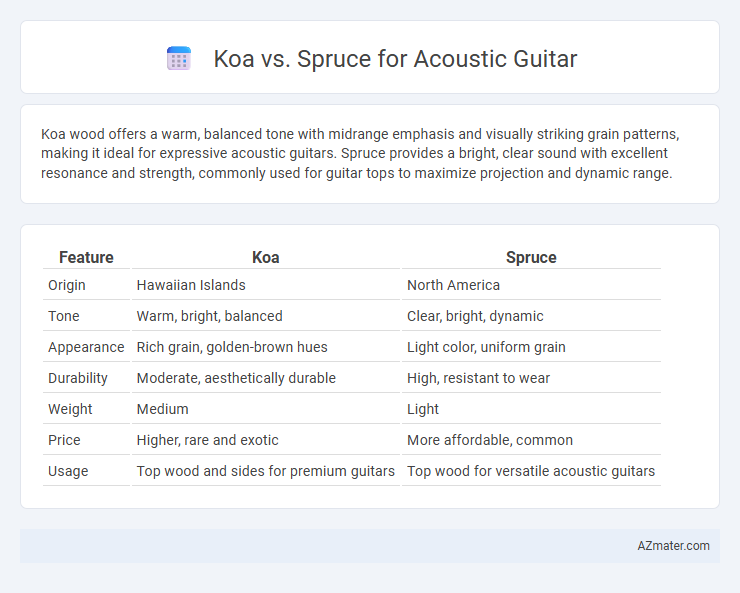Koa wood offers a warm, balanced tone with midrange emphasis and visually striking grain patterns, making it ideal for expressive acoustic guitars. Spruce provides a bright, clear sound with excellent resonance and strength, commonly used for guitar tops to maximize projection and dynamic range.
Table of Comparison
| Feature | Koa | Spruce |
|---|---|---|
| Origin | Hawaiian Islands | North America |
| Tone | Warm, bright, balanced | Clear, bright, dynamic |
| Appearance | Rich grain, golden-brown hues | Light color, uniform grain |
| Durability | Moderate, aesthetically durable | High, resistant to wear |
| Weight | Medium | Light |
| Price | Higher, rare and exotic | More affordable, common |
| Usage | Top wood and sides for premium guitars | Top wood for versatile acoustic guitars |
Overview: Koa vs Spruce in Acoustic Guitars
Koa and spruce are two popular tonewoods used in acoustic guitars, each offering distinct sonic characteristics and aesthetic appeal. Koa wood, native to Hawaii, provides a warm, balanced tone with a midrange emphasis and a shimmering, bright clarity as it ages, making it ideal for fingerpicking and blues styles. Spruce, especially Sitka spruce, is renowned for its dynamic range, strong projection, and versatility, delivering a crisp, clear sound favored by strummers and flatpickers across various music genres.
Origin and Characteristics of Koa Wood
Koa wood, sourced exclusively from the Hawaiian islands, is prized for its striking grain patterns and warm, bright tonal qualities, making it a favorite for acoustic guitar backs and sides. Unlike spruce, which is native to regions like Europe and North America and known for its clear, punchy sound, koa offers a unique sonic blend of brightness and midrange complexity ideal for versatile playing styles. The wood's density and stiffness contribute to a balanced tone with enhanced sustain, appealing to musicians seeking both aesthetic beauty and rich sound.
Spruce: The Popular Choice for Soundboards
Spruce is the preferred wood for acoustic guitar soundboards due to its exceptional strength-to-weight ratio, providing a bright, resonant tone with excellent dynamic range. Its ability to enhance sustain and clarity makes it a favorite among professional luthiers and musicians seeking versatile sound quality across various playing styles. While koa offers a unique aesthetic and midrange warmth, spruce remains the standard for achieving optimal projection and articulation in acoustic guitars.
Tonal Qualities: How Koa and Spruce Differ
Koa wood produces a warm, midrange-focused tone with rich, complex overtones and a natural compression that accentuates note clarity on acoustic guitars. Spruce offers a brighter, more articulate sound with greater dynamic range and pronounced attack, making it ideal for projecting clear, crisp notes in various playing styles. When comparing tonal qualities, Koa delivers a balanced, sweet sound that evolves with playing, while Spruce maintains consistent brightness and responsiveness throughout.
Visual Appeal: Grain, Color, and Aesthetics
Koa wood is prized for its rich, warm hues ranging from golden brown to deep amber, often displaying striking curly or figured grain patterns that create a visually vibrant acoustic guitar top. Spruce, in contrast, features a lighter, pale cream to off-white color with a straighter, more uniform grain, emphasizing a clean and classic aesthetic favored for its simplicity and elegance. While Koa offers a more dramatic and exotic look with its varied texture and warmth, Spruce appeals to players seeking traditional beauty and understated grain patterns on their guitars.
Durability and Aging Properties
Koa wood offers exceptional durability and develops a rich, warm tone with age, enhancing the acoustic guitar's resonance and sustain over time. Spruce, while less dense than koa, provides strong structural integrity and aids in projecting bright, clear sound, improving its tonal quality as the wood matures. Both woods age gracefully, but koa's natural oils contribute to its superior resistance to environmental changes, making it a preferred choice for long-lasting acoustic guitars.
Common Guitar Models Featuring Koa
Common acoustic guitar models featuring koa include the Taylor 814ce, Martin D-28K, and Gibson Songwriter Koa, prized for their balanced tonal warmth and attractive figure. Koa wood provides a bright midrange with crisp trebles and a slightly scooped bass response, appealing to players seeking clarity and projection in fingerstyle and strumming. This tonewood's dense grain also contributes to enhanced sustain and a natural compression effect, making koa guitars versatile for various musical styles.
Spruce-Top Guitars: Industry Standards
Spruce-top guitars are widely regarded as the industry standard for acoustic guitars due to their bright, clear tone and strong projection. Spruce wood, especially Sitka spruce, offers a balanced sound with a wide dynamic range, making it the top choice for professional musicians and manufacturers. Compared to koa, which produces a warmer and more midrange-focused sound, spruce tops provide greater versatility across genres and playing styles.
Player Preferences: Style and Genre Suitability
Koa wood offers a bright, focused tone with midrange warmth favored by folk and blues guitarists seeking clarity and resonance. Spruce tops provide a balanced, dynamic sound ideal for versatile genres including rock, pop, and fingerstyle, enhancing player expression and articulation. Preferences often hinge on style, with koa preferred for its unique tonal color and spruce for its responsiveness across varied playing techniques.
Price and Availability Comparison
Koa wood guitars generally have a higher price range due to the rarity and premium quality of Hawaiian koa, with prices often starting around $1,000 and reaching several thousand dollars for well-crafted models. Spruce top guitars are typically more affordable and readily available, with entry-level options starting under $200 and a wide range of mid-priced instruments commonly found in music stores worldwide. The availability of spruce guitars is significantly broader, making them a practical choice for beginners and intermediates, while koa guitars appeal to collectors and enthusiasts seeking unique tonal characteristics and aesthetic appeal.

Infographic: Koa vs Spruce for Acoustic Guitar
 azmater.com
azmater.com